Birdwatching in the Florida Keys is one of my favorite things to do when we’re visiting. I’m the only one in our family that really gets into it, but the wildlife in the Florida Keys is just so awesome, how can I not?! From small colorful birds to humongous wading birds, it’s kind of thrilling to bring your binoculars wherever you’re going, or to bring a big telephoto lens, and spy on EVERY bird you see.
We’ve got tips for birdwatching in the Florida Keys from Key Largo all the way out to Dry Tortugas National Park. Even if you’re not planning time dedicated to setting up a birding chair on the flats, you’ll still enjoy the wildlife we’re going to share. And if you’re a pro at this and want to share your tips or have more questions, please leave a comment or send us a note. We’re always happy to learn or tell more about travel in the Florida Keys!
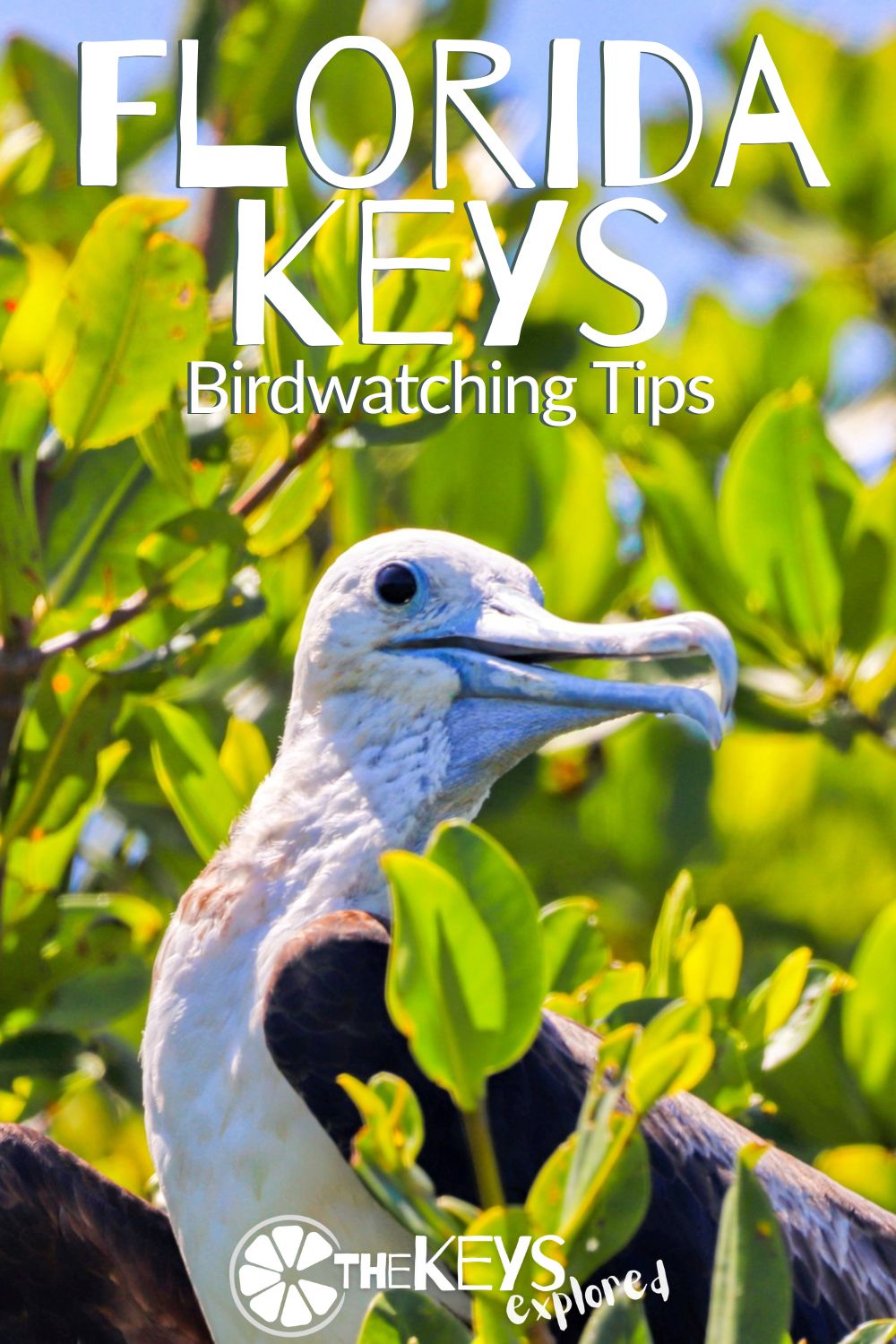
Where to Go Birdwatching in the Florida Keys
Not easily accessible to motorized boat traffic, the backcountry area is largely untraveled, unspoiled and teeming with fascinating plant and animal life. Birding in the Florida Keys is worth its own trip. It’s a bird watcher’s paradise, and with kids is just as good as an open ocean safari. Avian inhabitants include roseate spoonbills, osprey, great white herons (very similar to great egrets, but not the same) and even some bald eagles.
If you pay close attention to the mangroves just above the water, you may spot kingfishers, green herons and limpkins. It’s very common to see the many types of egrets and herons, including the great egret, great blue heron, snowy egret and cattle egret, but if you’re lucky, you might also be able to see a tri-colored heron or roseate spoonbill too.
And keep your eyes peeled for pelicans and cormorants. Although they are both very common throughout the Florida Keys, they’re remarkable birds to observe. Watch for cormorants gathering in the shallows and then diving. And when it comes to pelicans, you’ll most commonly see the common brown pelican, but in the winter months if you’re lucky you may spot some American white pelicans. The white pelicans are WAAAYYY bigger and are really a treat to see!
With over 400 species of birds recorded, there is no shortage of opportunities for Birdwatching in the Florida Keys. Enthusiasts can observe and appreciate the avian diversity of the area. Whether you’re a seasoned birder or a beginner, the Florida Keys offers a fascinating and rewarding birdwatching experience that is sure to leave you with unforgettable memories.
Best Birdwatching Stops on the Overseas Highway
Part of heading this way is enjoying all the stops along the Florida Keys road trip. Departing from the Miami or Naples / Everglades National Park areas, you’ll have countless opportunities to stop along the drive. The first stop for birdwatching in the Florida Keys is literally right when you arrive on Key Largo: make that first LEFT!!! You’ll come to Dagny Johnson Key Largo Hammock Botanical State Park almost immediately. More great Key Largo birdwatching spots include the Laura Quinn Wild Bird Sanctuary and John Pennekamp Coral Reef State Park.
As you continue south, the Middle Keys are full of great stops too! Long Key State Park, Curry Hammock State Park, Indian Fill Key and Pigeon Key Historic District are all fantastic places to stop for bird watching. These are great places for kayaking in the Florida Keys too!
When you get to the Lower Keys, Bahia Honda State Park and the west side of the Old Bahia Honda Bridge are two of our favorite birdwatching spots. Continuing on, the National Key Deer Refuge on Big Pine Key is great, and then Key West National Wildlife Refuge (accessible by boat), Key West Tropical Forest & Botanical Garden, and Dry Tortugas National Park (book passage here).
There are many more, but these are our top picks for birdwatching in the Florida Keys. You’ll find that, in general, this is one of the most interesting things to do in the Keys and it’s great if you’re doing the Florida Keys on a budget!
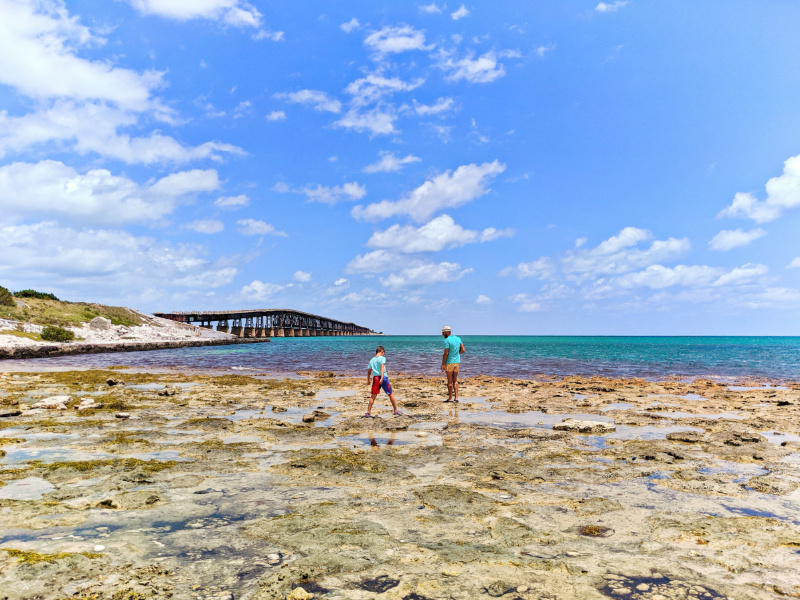
11 Unique Species of Birds in the Florida Keys
The Florida Keys is home to a wide variety of bird species, ranging from common shorebirds and waterfowl to rare and unique species found only in this region. Here are 11 of the most unique birds to look for when visiting the Florida Keys:
Rare Birdwatching in the Florida Keys
We’ll start with some of the most difficult birds to spot when you’re birdwatching in the Florida Keys and then we’ll get to the more common ones. Everyone is at a different level with their birding skills and patience, so make yourself a little list of what you want to be sure to see and then keep your eyes peeled!
Check out our favorite wildlife tours in the Keys for great expedition options!
Key West Quail-Dove – This rare and elusive bird is found only in the Florida Keys and a few other small areas in the Caribbean. It’s a small, brownish dove with a distinctive pattern of white spots on its wings. You’ll hear them before you see them. The Key West Tropical Forest and Botanical Garden is a great place to watch for them!
Black-whiskered Vireo – This small, greenish bird has a black mask and distinctive white “whiskers” on its face. It’s found in tropical forests and woodlands throughout the Keys, and is a favorite of birdwatchers. I have yet to see one myself, so I’m always on the lookout for one.
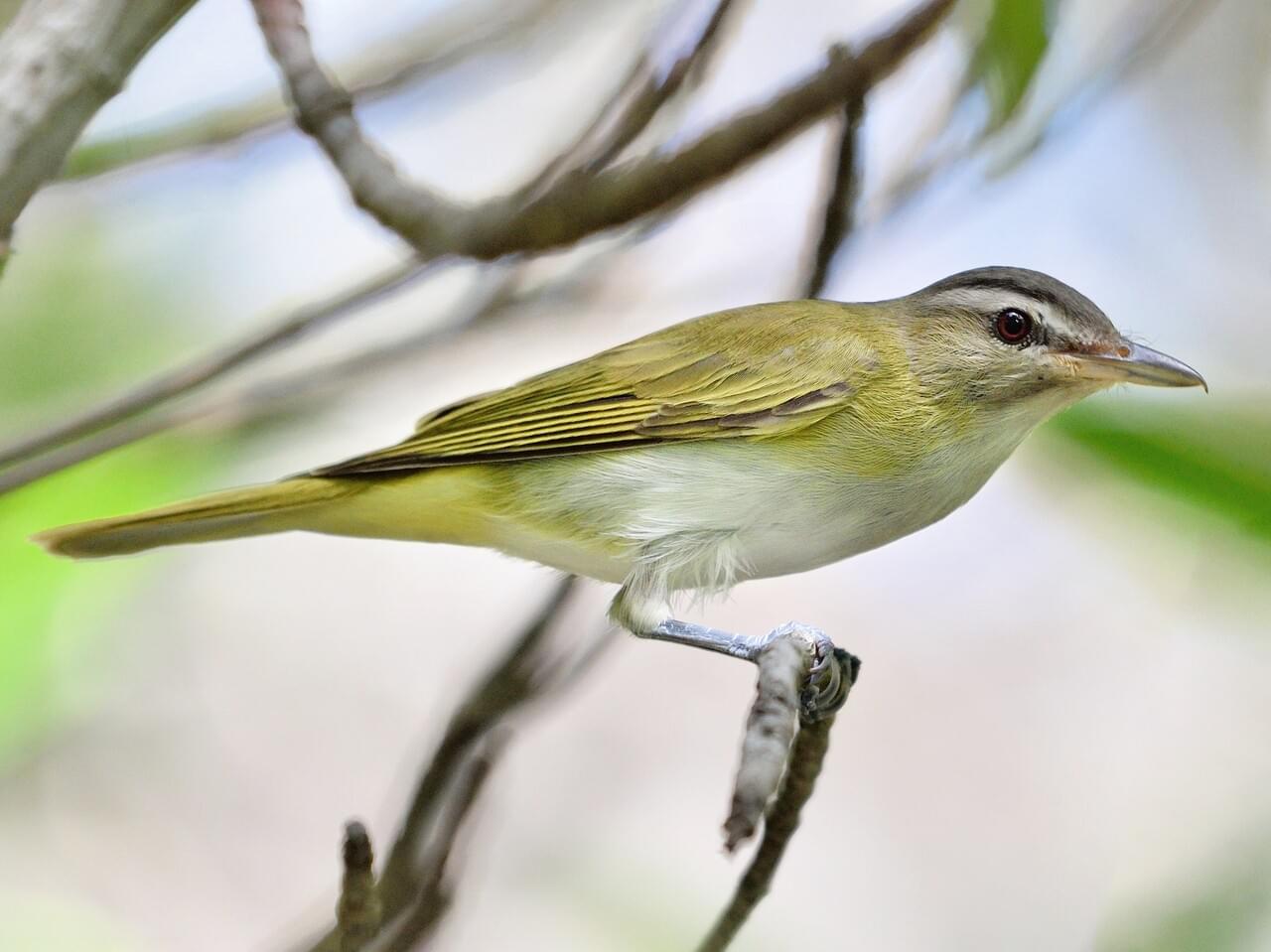
Mangrove Cuckoo – This secretive bird is found primarily in mangrove swamps and other coastal habitats in the Florida Keys. It has a distinctive call that sounds like “coo-coo-coo-coo,” and is often heard but not seen. There are other types of cuckoo you can see in the Southeast, including the yellow billed cuckoo (my favorite type of cuckoo bird; common in Congaree National Park).
American Flamingo – While flamingos aren’t common in Florida, a small population of American Flamingos has established itself in the Florida Keys following 2022’s Hurricane Idalia, making rare appearances and always causing a stir when people see them. These birds are known for their bright pink plumage and distinctive curved bills, and if you see one, consider yourself SUPER LUCKY and then report it to Florida Fish & Wildlife. Flamingos in the Florida Keys are exceptionally rare since they were hunted to near extinction, so if one or two fly in, it’s really a treat for anyone into birdwatching in the Florida Keys.
Tip: you should always keep a good distance from wildlife in general, but flamingos even more so. They spook very easily and we want to ALL get to see them. Do not go creeping across the flats to get closer and scare them away, ruining everyone else’s opportunity to see flamingos in the Florida Keys.
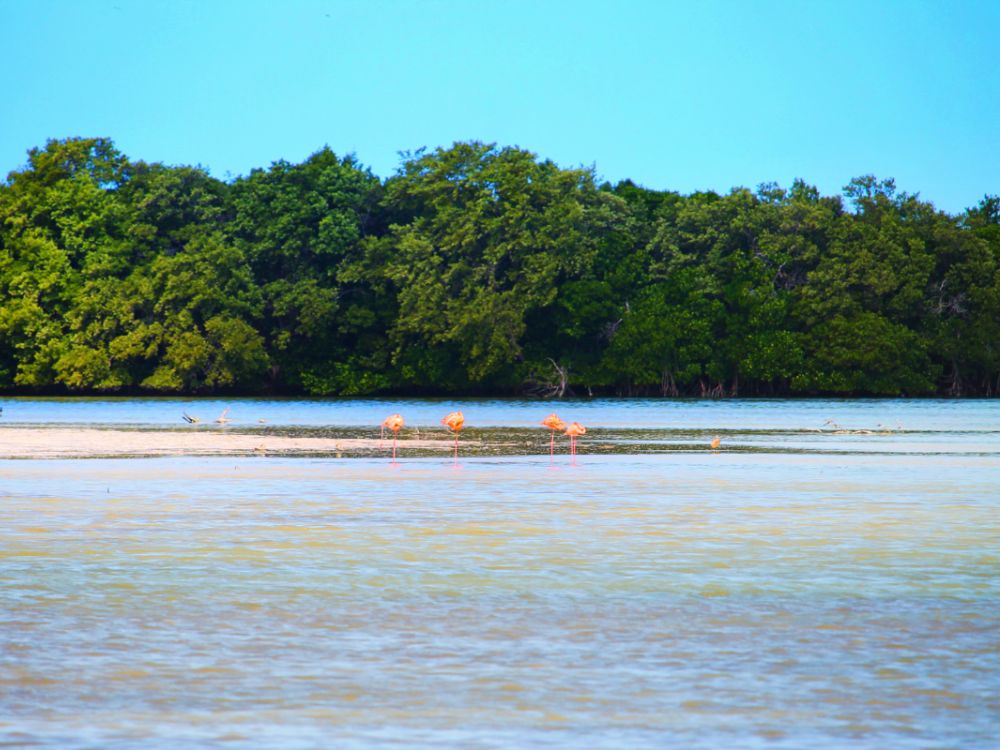
Reddish Egret – This large, long-legged wading bird is found in shallow coastal waters and wetlands throughout the Florida Keys. It has a distinctive shaggy appearance and a habit of dancing and jumping around in the water to stir up prey.
Würdemann’s Heron – I love this bird. The Würdemann’s heron is a hybrid of two more common birds: the Great Blue Heron and the Great White Heron. The specific color morph pattern of the Würdemann’s heron is the result of these two species mating. You’ll see them throughout the state, and when you’re birdwatching in the Florida Keys, you’ll be able to see a lot of them within the Key West National Wildlife Refugue.
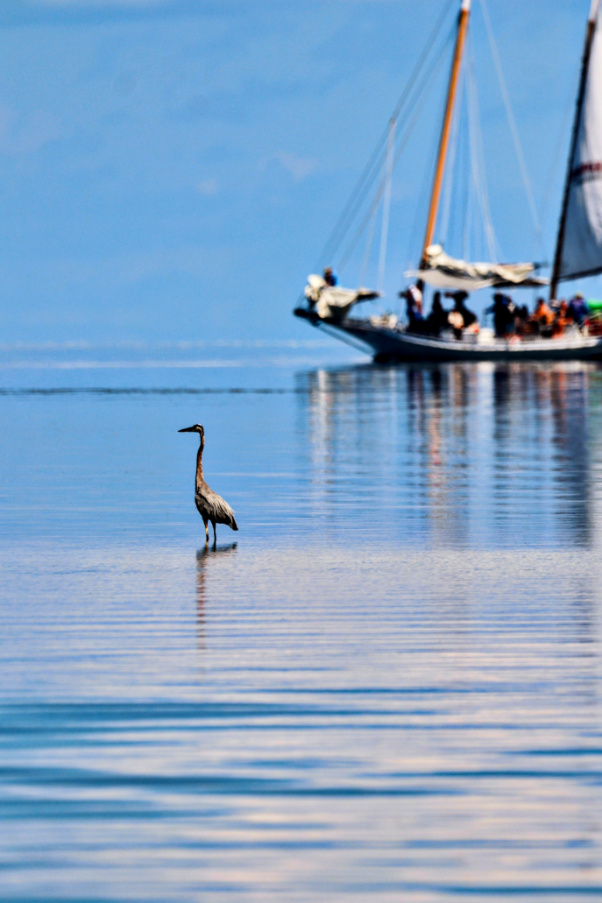
Common but Cool Birdwatching in the Florida Keys
I’m not picky about birdwatching in the Florida Keys. If it’s pretty, has something unique about it and flies, I’m happy to observe and photograph it. While the birds noted below have strong populations in the Keys, they are still wonderfully unique and a joy to watch.
White-crowned Pigeon – This bird is a large, grayish pigeon with a distinctive white crown on its head. It’s found primarily in the Caribbean and the Florida Keys, and is a threatened species due to habitat loss and hunting.

Magnificent Frigatebird – These large, black seabirds are known for their impressive wingspan of up to 7.5 feet. They’re commonly seen soaring over the open water, and are often spotted around the Florida Keys. You might think of frigate birds as having the bright red chests that swell up. That’s correct, but they only look that way during mating season and it’s only the males who’ve really been though it. Juvenile frigate birds are really cool to see, with bluish beaks and totally curious spirits!
Note: the most frigatebirds I’ve ever seen in one location was actually on Bush Key in Dry Tortugas National Park. People aren’t allowed on Bush Key, but you can walk along Garden Key to get near it. Really awesome to see with binoculars or a good telephoto lens.
Roseate Spoonbill – With its bright pink plumage and nifty spoon-shaped bill, this bird is hard to miss. It’s found in shallow waters and wetlands throughout Florida, but is particularly common in the Keys in winter. I love spoonbills and even though I see them every day I still get excited for them.
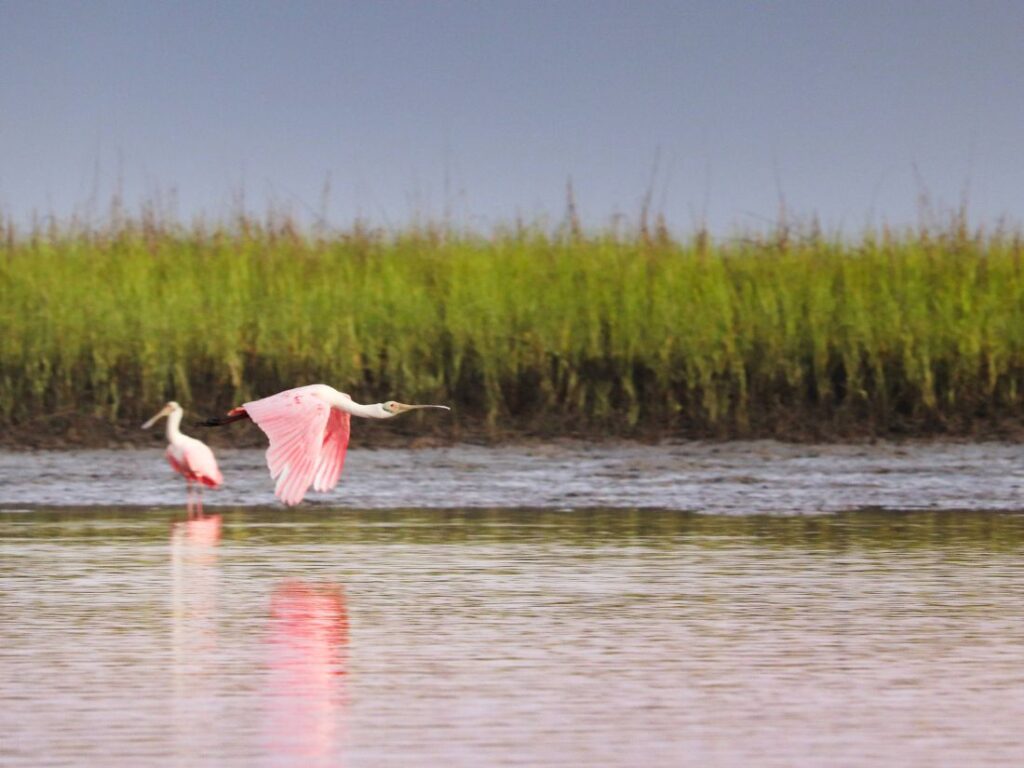
Gray Kingbird – This sleek, gray bird is found throughout the Caribbean and the southern United States, but is particularly common in the Florida Keys. It’s known for its aggressive behavior and its habit of chasing off other birds.
Key West Piping Plover – This small, sand-colored shorebird is found only in the Florida Keys and a few other areas along the Gulf Coast. It’s a threatened species due to habitat loss and disturbance, and is a favorite of birdwatchers and conservationists alike. This is one of those birds that you have to know what you’re looking for and then be discerning in determining what you’re looking at. They’re really cute and can be easily confused with other plover species.

Clearing Up Confusion about Birdwatching in the Florida Keys
People assume that because the Florida Keys are mysterious and tropical that they are full of all sorts of unique creatures. Well, yes they are, but it’s not all flamingos and giant purple parrots. Here’s the breakdown of what some people expect to see when birdwatching in the Florida Keys and the reality of some of the more exotic species.
Are there Flamingos in the Florida Keys?
American Flamingos can be found in the Florida Keys, very rarely. While flamingos are not native to Florida, a small population of American Flamingos has established itself in the Florida Keys, coming and going over the years. These birds boast bright pink plumage and distinctive curved bills, and they inhabit shallow coastal waters and wetlands throughout the Keys. Flamingo sightings in the Florida Keys are rare due to their secretive nature and the fact that they, along with spoonbills and great egrets were basically hunted to near extinction during Florida’s pluming days (feather industry).
If you see a news story about seeing flamingos in the Keys, head there right away and be prepared for a complete frenzy. Birdwatching really gets turnt when a phenomena like this happens and it’s usually only for a few weeks that even just one flamingo will be in the Florida Keys.
NOTE: after Hurricane Idalia (summer 2023) a LOT of flamingos were swept up into Florida and they’ve since been seen from the Florida Keys all the way up to St Marks National Wildlife Refuge in Tallahassee! Hopefully these small flocks will continue to stick around. I’ll keep this article updated as flamingo populations shift.
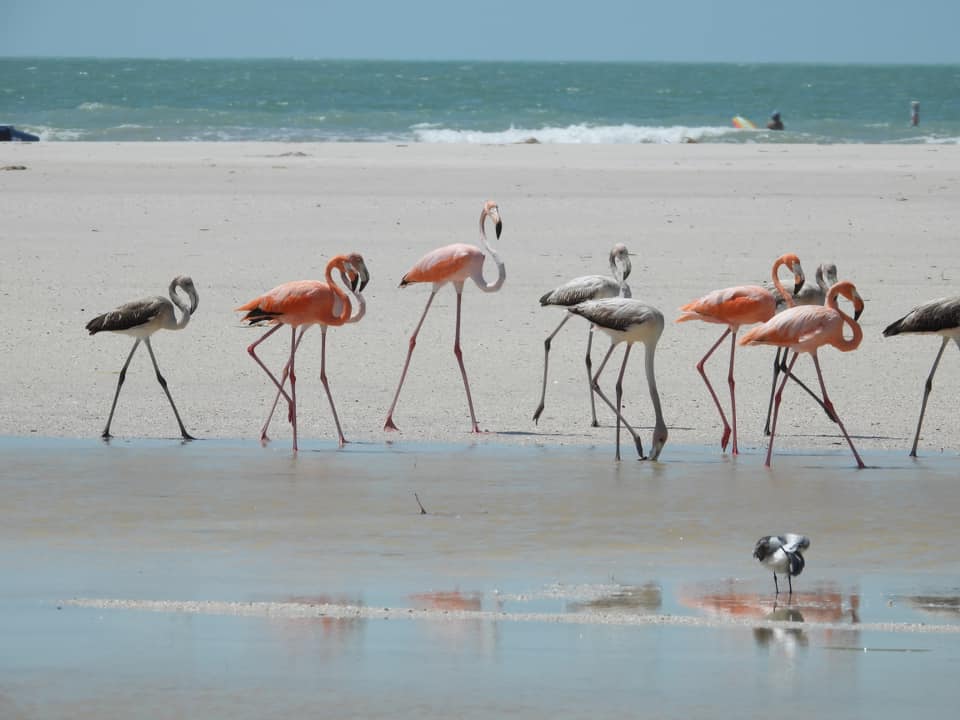
Can you see Scarlet Ibises in the Florida Keys?
I wish; Scarlet ibises are one of my absolute favorite birds! People occasionally spot Scarlet Ibises in Florida and the Florida Keys, although they are not native to the region. However, sightings of Scarlet Ibises in the Florida Keys are relatively rare and unreliable. For those interested in seeing Scarlet Ibises, it’s best to visit their South American natural habitat, where they thrive in countries like Guyana, Suriname, and Venezuela. If you happen to see a scarlet ibis in Florida, it’s likely due to being either illegally imported or it’s escaped from a zoo. Bummer.
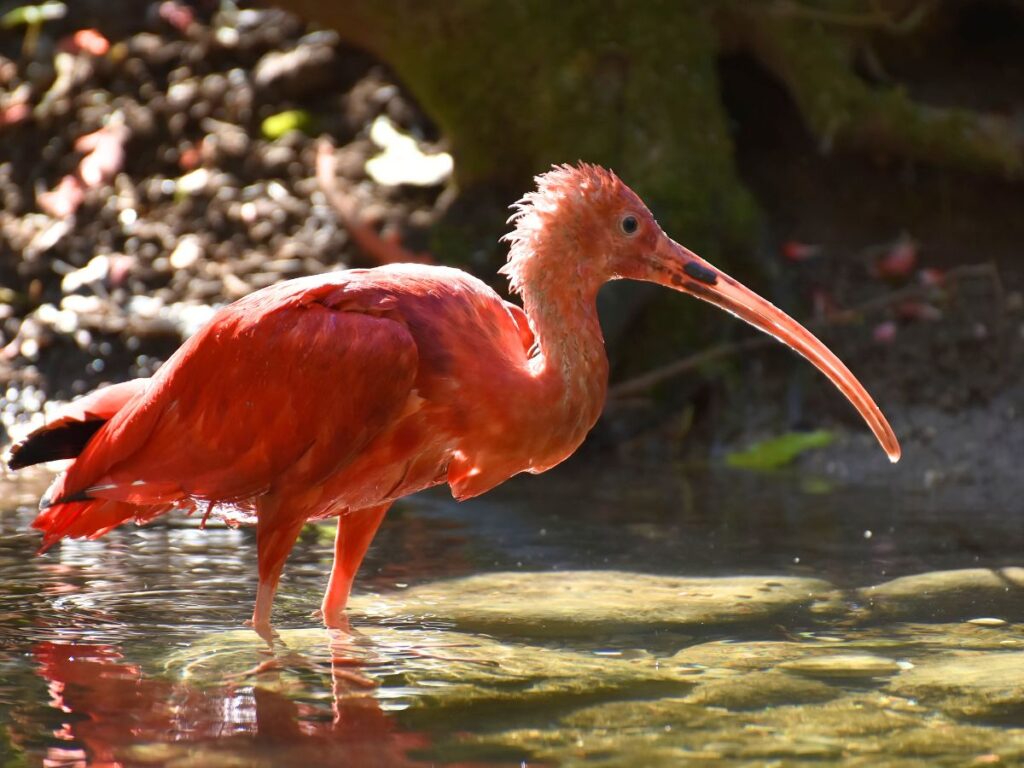
Are there Parrots in the Florida Keys?
There are several species of parrots that can be spotted while birdwatching in the Florida Keys. Many of these are not native to the region. The most common parrots in the Keys are the Yellow-fronted Amazon, native to the Caribbean (but not endemic to the Keys). These birds have established populations up into South Florida even if you rarely see them. Other parrot species spotted in the Keys: the Cuban Amazon, Blue-fronted Amazon, and Red-masked Parakeet, many of which are the result of escaped or released bird populations, displaced flocks, or human interference.
While delightful to observe, parrots can harm the local ecosystem and native bird species. They may be pretty and a treat to spot while birdwatching in the Florida Keys, but they don’t necessarily belong here.
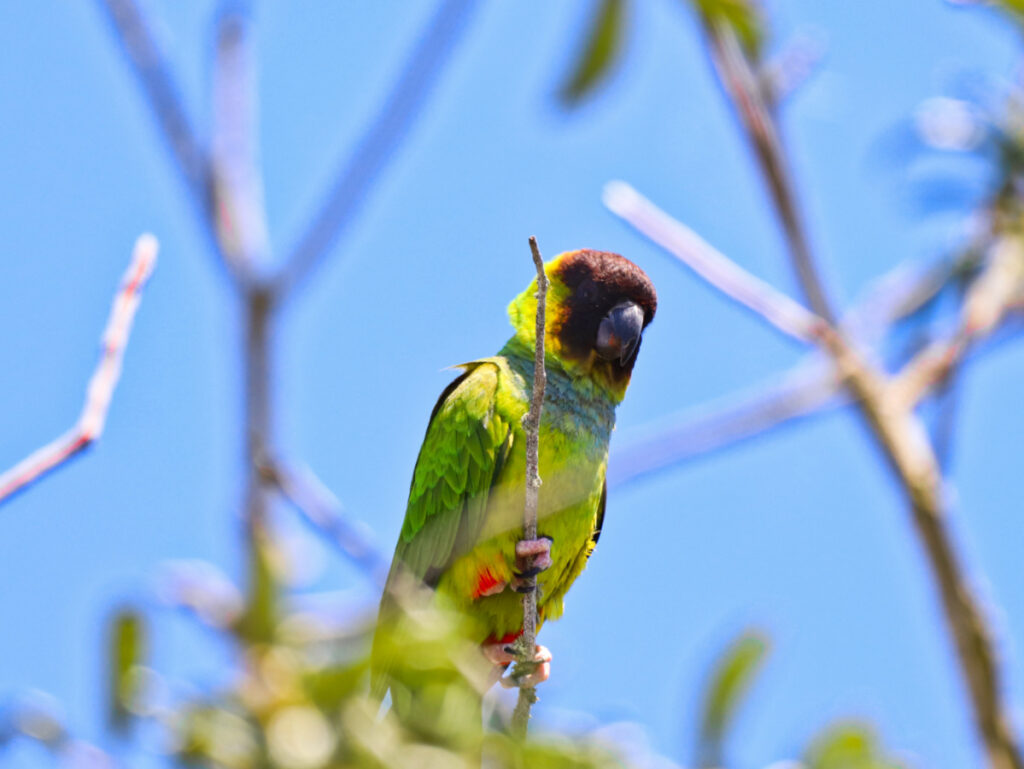
Frequently Asked Questions about Birdwatching in the Florida Keys
Even though bird watching can be as easy as just keeping your eyes peeled or pulling over on the side of the highway, there’s a lot of information that will help you have the best experience, particularly in the Florida Keys.
What time of year is best for bird watching in the Florida Keys?
The best time for Florida Keys birdwatching is winter (November – March) when migratory species visit. There are TONS of birds year round, but in the winter months places like the Key West National Wildlife Refuge are crazy with birds!
Where are the best places to go bird watching in the Florida Keys?
Top birdwatching spots in the lower Keys include the Key West National Wildlife Refuge (accessible by boat), Key West Tropical Forest & Botanical Garden, National Key Deer Refuge, and Dry Tortugas National Park (book passage here). Middle Keys: Long Key State Park, Curry Hammock State Park, Indian Fill Key. Upper Keys: Dagny Johnson Key Largo Hammock Botanical State Park, Laura Quinn Wild Bird Sanctuary, John Pennekamp Coral Reef State Park. There are many more, but these are our top picks for birdwatching in the Florida Keys.
What types of birds can I expect to see in the Florida Keys?
The Florida Keys house diverse bird species, including shorebirds, waterfowl, raptors, and tropical parrots and toucans (escaped, not native). See above for more information about the many bird species to watch for.
Do I need any special equipment for bird watching in the Florida Keys?
Essential in the Florida Keys for birdwatching: a good pair of binoculars for spotting elusive species (we have THESE ONES), particularly the larger birds you see out in the flats. A field guide to Florida birds can also be helpful in identifying species. We have THIS FLORIDA BIRD BOOK and THIS POCKET GUIDE. If you’re into photography, a good telephoto is also amazing to have. I LOVE my 600mm Sigma lens for my Canon Rebel T7i.
Are there any birding tours or groups in the Florida Keys?
Numerous birding tours in the Florida Keys offer expert guidance and assistance for spotting and identifying bird species. Check out our guide to Wildlife Tours in the Florida Keys for our top picks through the whole island chain.
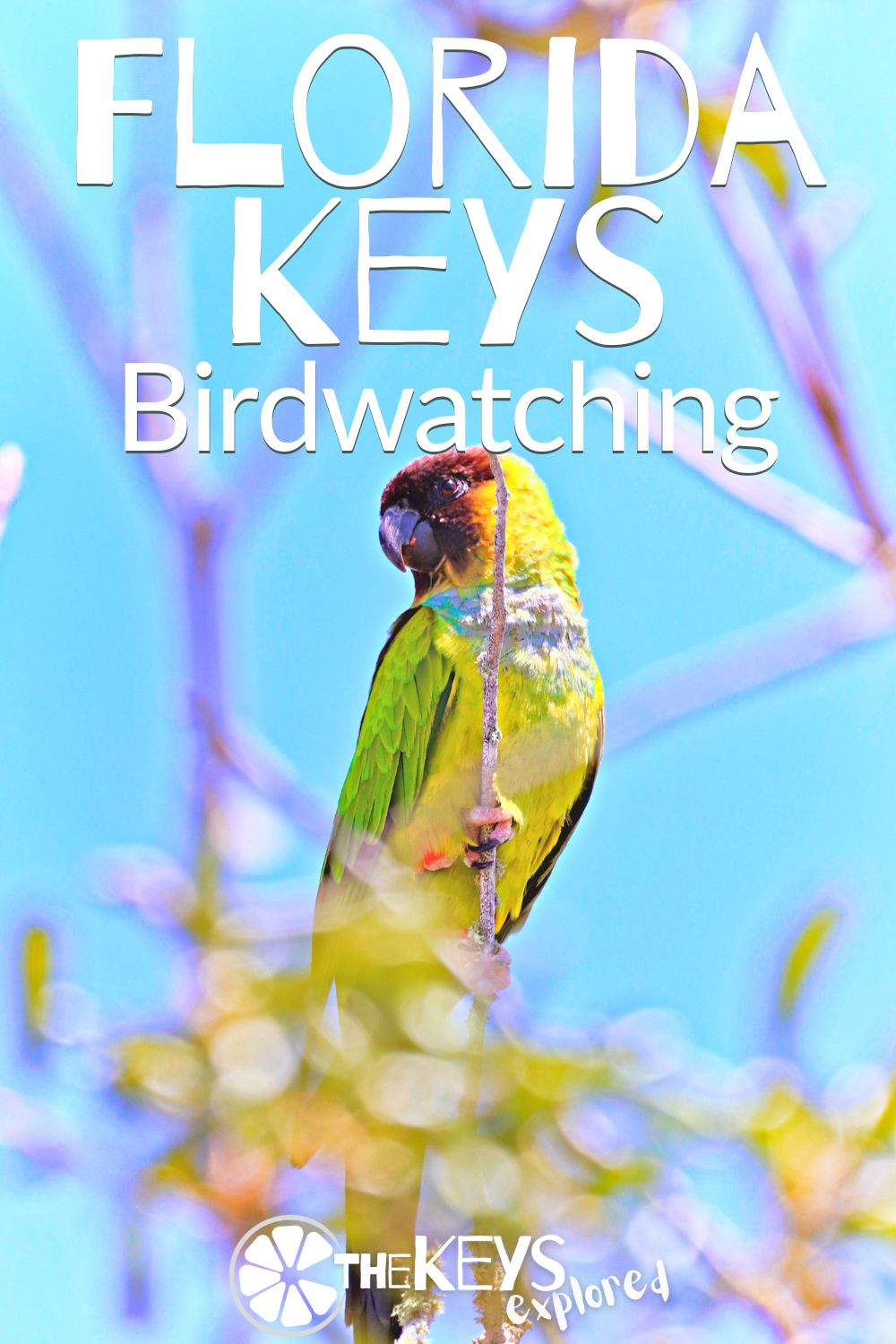

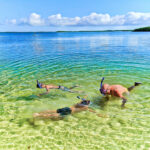
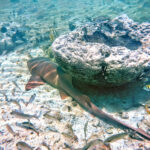
Pingback: Wildlife in Maine: Spotting Moose, Puffins and More
Pingback: Fun Things to Do on Key Largo in the Beautiful Florida Keys - The Keys Explored
Pingback: Guide to John Pennekamp Coral Reef State Park, Key Largo in the Florida Keys - The Keys Explored
Pingback: Great Things to do on Marathon and the Lower Keys - The Keys Explored
Pingback: Kayaking tour at Geiger Key: Key West Kayaking Wonderland